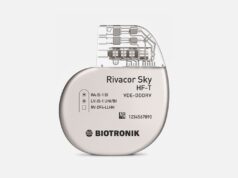Patients with refractory reflex vasovagal syncope who received a pacemaker programmed with Closed Loop Stimulation (DDD-CLS, algorithm from Biotronik) had a seven-fold reduction in fainting compared with patients in a placebo pacing group, according to results from the SPAIN study.
The prospective, double-blind, randomised, placebo-controlled study met its primary endpoint of a significant reduction (≥50%) in fainting episodes with DDD-CLS compared to placebo pacing, noted study’s lead author Gonzalo Baron Esquivias (Virgen del Rocio University Hospital, Seville, Spain) at a late-breaking trial session at the 2017 Scientific Session of the American College of Cardiology (ACC; 17–19 March, Washington, DC, USA).
Earlier small trials of DDD-CLS had shown mixed results in preventing fainting episodes, Baron Esquivias said. “This study is important because of the lack of available treatments for recurrent syncope. Now a door is open and we have a new possible treatment for these patients,” he noted.
Pacemakers with DDD-CLS detect contractions in the heart muscle that typically occur before an episode of syncope and release an electrical signal that calms the heart down, preventing sudden dips in heart rate and blood pressure.
In the SPAIN trial, 54 patients aged 40 or older from 12 medical centres in Spain and Canada were enrolled. All patients had experienced more than five episodes of syncope in their lifetimes, with more than two in the past year. To be eligible, participants had to have normal results on an electrocardiogram, echocardiogram, 24-hour Holter test, carotid sinus massage and orthostatic test. They also had to show a drop in blood pressure and heart rate.
All participants were implanted with a pacemaker. The researchers randomly assigned half to receive DDD-CLS pacing for 12 months and the other half to receive pacing in DDI mode, which does not respond to the contractions in the heart that precede syncope and, therefore, functioned in the SPAIN trial as a placebo group. After 12 months, the two groups were switched so that the patients who had received DDD-CLS during the first year received DDI for the next 12 months, and vice versa. If a patient in either group had more than three episodes of syncope in one month, their pacing assignment was switched. Patients and their doctors were blinded at all times to their group assignment.
After two years, 46 patients completed the trial. The patients’ average age was 56, and 48% of them were men. During the trial, four patients experienced syncope while receiving DDD-CLS pacing, compared with 21 patients who fainted during DDI pacing, a statistically significant difference.
Among patients initially assigned to DDD-CLS, 72.2% saw a reduction of more than 50% in syncope episodes within the first year, but fainting recurred after they crossed over to the DDI group. Patients who crossed over to DDD-CLS after a year of placebo pacing saw a reduction of more than 50% in syncope episodes during the second year. Nine patients who initially received DDI pacing met the criterion for early crossover to DDD-CLS during the first year. The estimated time to a first fainting episode was longer among patients receiving DDD-CLS––29 months compared with just over nine months for patients receiving DDI, a statistically significant difference.
Limitations of the study are its small size and short duration of follow-up (two years), Baron-Esquivias said.
Baron-Esquivias, who currently uses DDD-CLS pacing to treat patients with recurrent syncope in his own practice, said that if these findings are confirmed by larger, ongoing studies, such as the ongoing BioSync CLS trial sponsored by Biotronik, he expects that international guidelines will be changed to recommend DDD-CLS pacing in these patients.
The trial was funded by the Investigation Agency of the Spanish Society of Cardiology, which received an unrestricted grant from Biotronik Spain.









